
Latest News
- Hyundai E&C applies smart EV charging solution to apartment buildings for the first time
- Hyundai E&C wins one of the world’s top three design awards for four consecutive years
- Hyundai E&C Signs PPA for Solar Renewables with Glennmont D&D Solar Holdings
- Hyundai E&C to Embark on UK SMR Project forging Korea-US-UK Technology Alliance
- Hyundai E&C Consolidates Leading Position in Concrete Safety and Quality Technology
[60-year energy history of Hyundai E&C ①] From energy independence to entrance into the global market
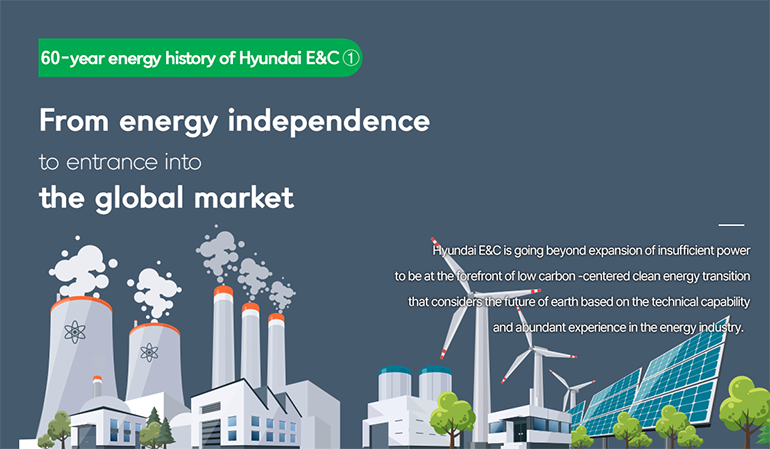
Reasonable transformation of Hyundai E&C
“The era of global warming has ended. The era of global boiling has arrived”
The remarks of UN Secretary-General António Guterres on global tropicalization was sufficient to alert the world. As if to prove this, July of this year was said to be the hottest summer on record, and Secretary-General António Guterres emphasized, “Many nations and corporates promised to counter climate change, but greenhouse emission continues to grow,” and added, “Ambitious renewable energy goals must be in line with the 1.5-degree limit.”
Immediate climate action called for by UN involve reducing energy that centers on fossil fuel such as coal and petrochemical with renewable energy and realizing carbon neutrality that creates the ‘zero’ state of carbon that is pointed out to be the main culprit of climate crisis. Recently, in addition to international organizations such as UN, the general public is also showing interest in ‘climate tech’ (a compound word that combines climate and tech), which is a technology that reduces carbon and greenhouse gas. Hyundai E&C is also taking part in the movements towards carbon neutrality in earnest. Hyundai E&C newly established the New Energy Business Unit that is dedicated to the renewable energy business and it restructured relevant organizations. In addition, last month, it entered into an agreement to produce and supply green power by constructing a PV power plant in Namdong National Industrial Complex of Incheon. Hyundai E&C is going through a change to supply renewable energy in full swing.
Against this backdrop, Hyundai E&C could proactively enter the energy business because it has knowhows about the corresponding industry that it accumulated for a long time by constructing energy infrastructure in Korea. Based on the spirit of Chung Ju-yung, the founding Chairman, to make ‘economic contribution to the country’, Hyundai E&C contributed to the power development plan of the government to resolve the post-war power shortage issue. Furthermore, it contributed to the development of power generation and relevant technical capabilities by executing various power-related construction projects. Hyundai E&C, that is doing its utmost to work on energy that makes the lives of people richer and convenient, should we take a deeper look into its 60-year energy history?
Living history of Korea’s advancement in power
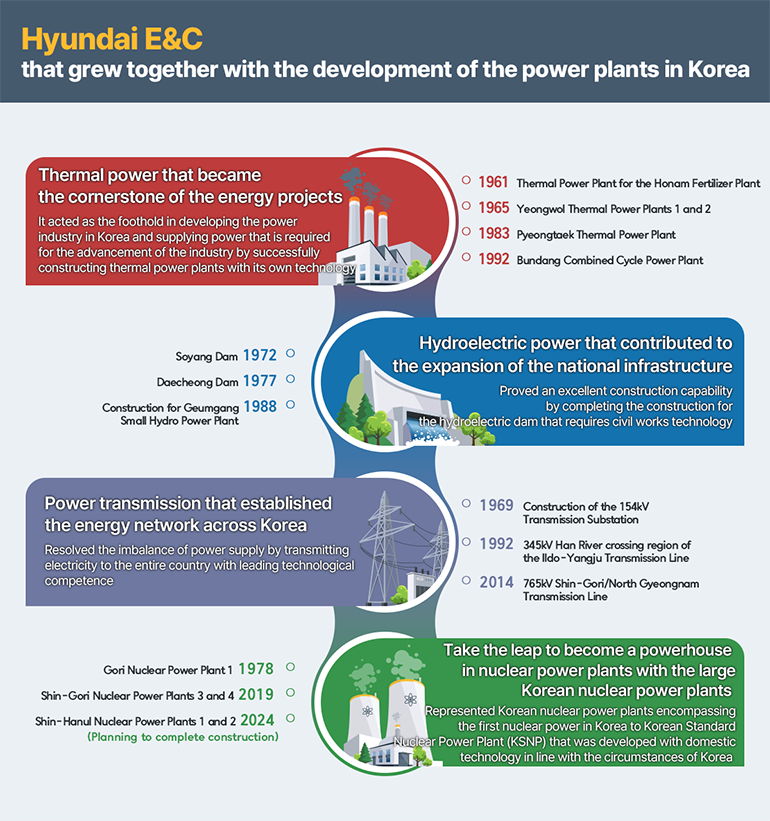
① Thermal power plant projects that set the cornerstone of the energy project history
Hyundai E&C first entered into the energy industry immediately after the Korean War. At the time, expanding the electricity grid was more urgently needed more than anything else because most had been lost due to the war. Hyundai E&C successfully executed the ‘construction of the thermal power plant for the Honam Fertilizer Plant (completed in 1961)’ to install two 11,250kW diesel power generators in line with the 5-year power development plant that started in the 1960s to leave its mark on the history to become the private construction company that independently constructed a power plant successfully for the first time in Korea.
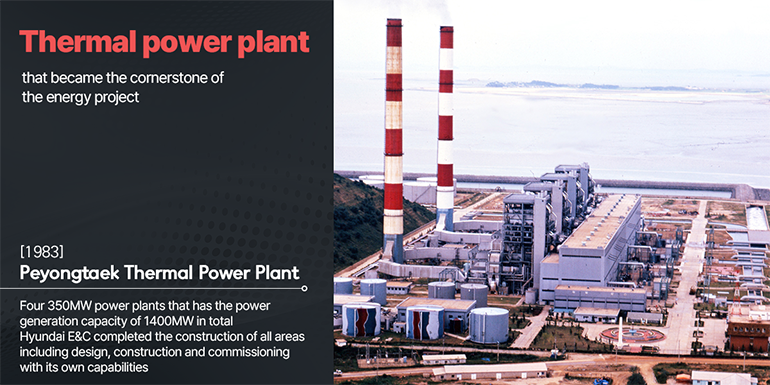
Afterwards, Hyundai E&C acted as the priming water for the development of power grid in Korea by constructing numerous thermal power plants across the country such as Busan Gamcheon Thermal Power Plant, Samcheok Thermal Power Plant, Yeongwol Thermal Power Plant 2 and Incheon Thermal Power Plant to secure power required for industrial development that was achieved at a fast pace in the 1970s. In particular, Hyundai E&C constructed the Pyeongtaek Thermal Power Plants 1~4 that were completed in 1983 with its own capabilities encompassing all areas including design, construction and commissioning to play a pivotal role in raising the construction capability of domestic power plants from the settling stage to the maturity stage. In addition, in the 1990s, it also took on the challenge to combine eco-friendly resources and enhancing power generation efficiency by jumping into the construction for combined cycle power plants that combine LNG gas turbines and steam turbines to bear the increasing power consumption. Bundang Combined Cycle Power Plant that started its commercial operation for the first time in 1992 contributed to supplying heat in addition to the stable supply of power to Bundang New Town as the first combined cycle power plant attempted by Hyundai E&C.
② Hydroelectric project that expanded the energy portfolio
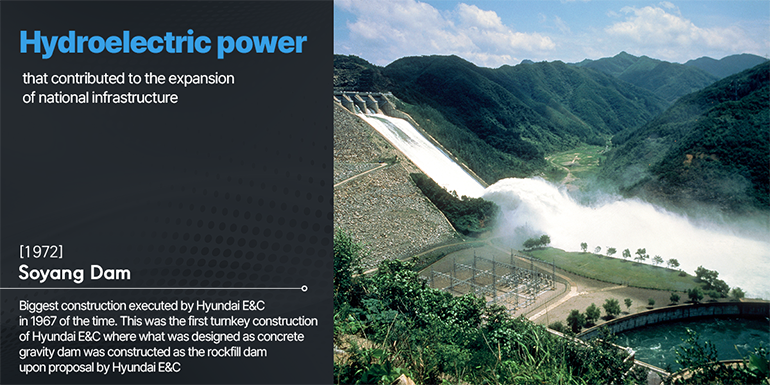
Following the development of thermal power plants, Hyundai E&C also delved into the hydroelectric power projects in line with the 10-year plan to comprehensively develop water resource by the government. Soyang River Multipurpose Dam that started its construction in 1967 was a large-scale civil works construction that is named to be one of the top 2 civil works construction in the 1960s together with the Gyeongbu Expressway, and it was a huge general construction to construct power generation facility that was 123m in height and 530m in embankment length, amounting to 200,000kW in total capacity with water storage capacity of 2.9 billion ton. Afterward, Hyundai E&C constructed dams in various parts of Korea such as Damyang Dam, Gyeongju Deokdong Dam and Milyang Dam in addition to Daecheong Multipurpose Dam, which is the first complex type dam (a blend of concrete dam and rockfill dam) in Korea that was constructed in 1977, to make accomplishments in the hydroelectric field as well, and contributed to the supply of electricity even to the backwoods by being in charge of the construction for the Geumgang Small Hydro Power Plant and the Bonghwa Small Hydro Power Plant in addition to the construction of the Yeoncheon Small Hydro Power Plant in 1985.
③ Transmission project that proved the competence of Hyundai E&C also in the electricity grid area
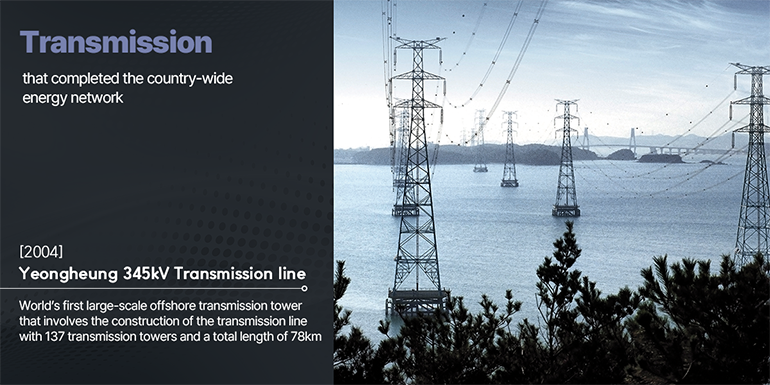
In order to supply desired power in the region that requires the generated electricity, transmission and transformation substations must also be constructed. After the Korean War, the transmission facilities consisted mostly of low capacity amounting to 22kV and 66kV, and in order to properly supply power in such weak circumstances, boosting the voltage of the transmission line was the utmost priority. Through the construction for the transmission line (completed in 1969) to connect the power generated from Yeongwol Thermal Power Plant to the metropolitan area, it first executed the construction for the 154kV transmission line. Afterwards, it made step-wise advancements to build 345kV and 765kV, and ultimately it led in adopting new technology in addition to development of power plants by making attempts, such as the Yeongheung offshore transmission line that aimed to build a mega transmission tower in the ocean for the first time in the world in 2004, to provide electricity in various parts of Korea.
④ Nuclear power plant project that led Hyundai E&C to become a representative player in K-nuclear power plants
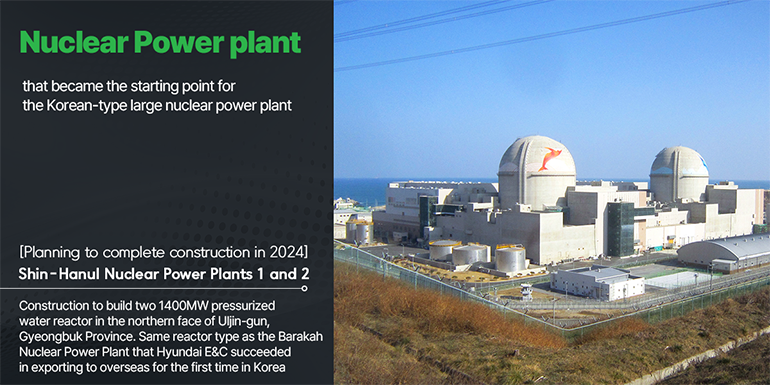
One of the remarkable achievements made by Hyundai E&C is the nuclear power plant. Until now, the size of the nuclear power plants that Hyundai E&C constructed amount to 24GW in total. Hyundai E&C not only constructed the greatest number of nuclear power plants among Korean construction companies but also has a track record of being the first to export its nuclear power plant overseas. Such nuclear power plant history of Hyundai E&C started with Gori Nuclear Power Plant 1, the first nuclear power plant in Korea. Hyundai E&C, that accumulated its construction experience while relying on overseas technology at the early stage, diligently built its construction capability through Gori Nuclear Power Plants 1~4 and Hanbit Nuclear Power Plants 1 and 2, and finally, it successfully constructed the Hanbit Nuclear Power Plants 3 and 4 as the project led by Korea in the 1990s to announce the birth of Korean Standard Nuclear Reactor (KSNR). As a result, Hyundai E&C participated as the main EPC for 22 out of 34 large Korean standard nuclear power plants that exist both in Korea and overseas and became the first construction company in Korea to have a track record of constructing with both the Pressurized Water Reactor* (PWR) and the Pressurized Heavy Water Reactor* (PHWR) method.
*Pressurized Water Reactor (PWR): Nuclear power plant that uses low enriched uranium (2~4%) as the fuel and light water (H2O) as the coolant.
*Pressurized Heavy Water Reactor (PHWR): Nuclear power plant that uses natural uranium as fuel and heavy water (D2O) as the coolant. Fuel can be replaced while in operation.
※ Wolseong nuclear power plants 1~4 use the PHWR method, and all other domestic nuclear power plants use the PWR method.
Going beyond Korea to head towards the world! Global power network of Hyundai E&C
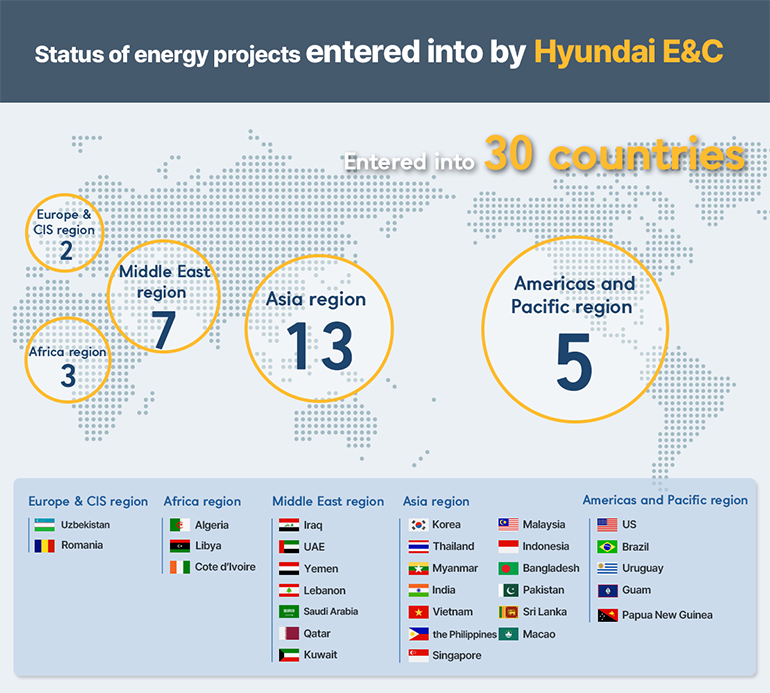
Hyundai E&C that led the domestic power projects also expanded its global influence. In particular, the electrification project carried out in Aseer region that is adjacent to the northwestern shore of Saudi Arabia in 1976 was the starting point for Hyundai E&C to bring about expansion of power in the Middle East. Hyundai E&C was in charge of the entire power facility from the power plant in the Aseer region to the transmission and the distribution line and the meter enclosure for the households to earn the absolute trust of the Saudi Electricity Company that issued an order. Following this, Hyundai E&C won order for the transmission line construction that targeted the wide undeveloped region of Saudi Arabia to contribute greatly to the construction of power infrastructure in the Middle East.
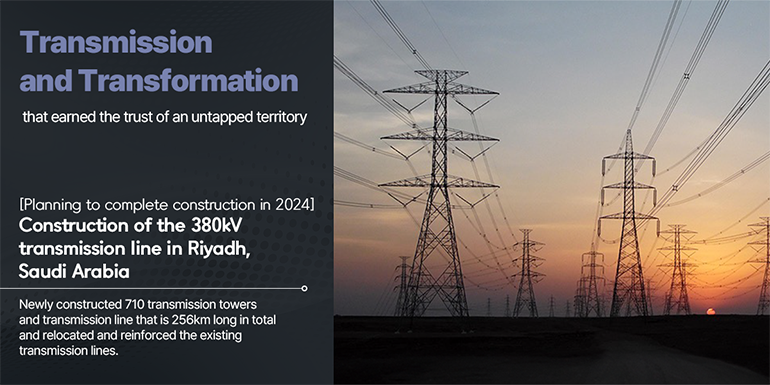
In particular, for the construction of 380kV transmission line that was ordered by the eastern province of the Saudi Electricity Company, all technology of Hyundai E&C became fixed as the standard for the transmission construction in Saudi Arabia so that ‘Hyundai Standard’ became a term that commonly used. The reputation of Hyundai E&C is still sustained in Saudi Arabia and it will also be supplying power to NEOM City that is known to become the largest future city on earth. Until now, Hyundai E&C executed about 70 transmission and transformation related projects in Saudi Arabia alone, including ‘Saudi Arabia NEOM-Yanbu 525kV High-Voltage Direct Current (HVDC) Construction Project’, and the total length of the transmission lines is 20,000km, long enough the circle half of the earth.
Also, Hyundai E&C was in charge of a wide scope from design to commissioning for substations and is diligently making its accomplishments in the Middle Eastern and Asian markets. In particular, it is playing a leading role in the advancement of the power network by successfully constructing the unmanned automated substation using digital technologies such as EHV (extra high voltage) gas-insulated switchgear* and air-insulated switchgear to stably supply power.
* Gas-insulated switchgear: The primary protection for power facilities installed in power plants or substations that protects the power system by quickly blocking excessive current in the event of a breakdown in addition to the normal operation of the switchgear.
* Air-insulated switchgear: The primary protection for power facilities installed in outdoor power plants or substations.
Moreover, Hyundai E&C is transcending borders and constructing various power plants with the construction of the Al-Khobar Thermal Power Plant in Saudi Arabia and the freshwater plant. Hyundai E&C is constructing various types of power plants such as hydroelectric, thermal, and combined cycle power plants in the Middle East, Southeast Asia, Latin America, Africa and CIS regions. In particular, it was recognized for its capability in energy technology by successfully winning order for power plants in overseas with the project to install four nuclear power plants with 1400MW capacity in UAE for the first time in 2009. Recently, it is accelerating its global entrance by expanding business areas to eco-friendly renewable energy that considers earth such as photovoltaic and wind power.

